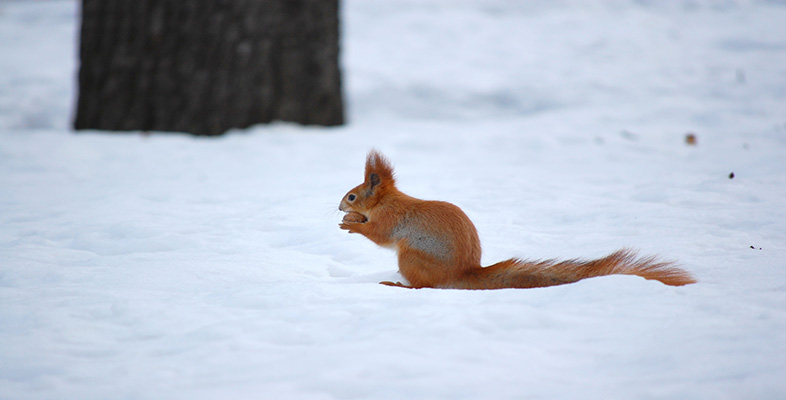1.1.1 A diversity of strategies
Faced with an environment that becomes relatively hostile with the onset of winter, an adult organism can, broadly speaking, do one of four things:
It can maintain an active lifestyle, adapting in various ways to the prevailing conditions. The robin (Erithacus rubecula) is an example of such a species; so are evergreen trees.
It can abandon an active lifestyle, adopting an inactive existence for the duration of winter. The hedgehog (Erinaceus europaeus) spends the winter in hibernation. Many plants remain dormant below ground during the winter.
It can die before the onset of winter, as many adult insects do, but their offspring can survive the winter, for example as an egg or a pupa. Some plants survive the winter as seeds.
It can leave, migrating to a part of the world where conditions are favourable during the winter months. Each year, swallows (Hirundo rustica) leave Britain in autumn and migrate to Africa, whilst other birds such as barnacle and pink-footed geese migrate to Britain from further north.
Each of these four strategies is more applicable to some kinds of organisms than others. Long-distance migration, for example, is only an option for species that can store energy or can feed continuously (e.g. reindeer, Rangifer tarandus). For each of the three groups of species in Table 1.1 there is one strategy that is not an option. Later in this course, we will focus on each strategy in turn, examining how it is manifested in different groups of organisms. Table 1.1 summarises these alternative strategies and gives some examples of organisms that use each of them. This table provides a conceptual framework for much of the course.
| Strategy | Plants | Insects | Vertebrates |
|---|---|---|---|
| 1 'Tough it out' | |||
| Maintain an active adult existence by altering behaviour and physiology with changing conditions. | Plants that continue to photosynthesise, e.g. evergreen trees. | Not an option for most insects. | Mammals that remain active, e.g. fox. Birds that remain active, e.g. robin. |
| 2 'Opt out' | |||
| Maintain an inactive existence as adults for the duration of the hostile period. | Perennial plants that survive the winter by dying down or going dormant above-ground and/or forming subterranean storage organs, e.g. bulbs and rhizomes. | Survive the hostile period in a state of torpor, e.g. certain wasps, bees and butterflies. | True hibernation in small mammals. Not an option for most birds. Winter torpor in amphibians and reptiles. Freeze-tolerance in amphibians. |
| 3 Juvenile survival | |||
| Survive the hostile period as some non-adult phase of the life cycle. | Survive the hostile period only in the form of seeds. | Survive the hostile period in the form of eggs, larvae or pupae. | Not an option for vertebrates |
| 4 'Go away' | |||
| Migrate as adults to a location where conditions are favourable. | Not an option for plants. | Some butterflies migrate north each spring and summer. | Migration in some birds and mammals. |
Each of the four strategies can be discussed at different levels of explanation. For example, with migration of birds we can consider the molecular and cellular processes involved in energy storage and its utilisation for long-distance flight. We can discuss the physiological and structural features of birds' wings that allow long distance flight. Alternatively, we can consider migration in an evolutionary context, discussing the selection pressures that favour migration. This approach leads us into the ideas of types of explanation. We will see firstly that organisms carry out certain activities, such as breeding, at those times of year when it is most adaptive for them to do so (i.e. to maximise their fitness) and, secondly, that those activities are performed in response to appropriate environmental cues. For example, many animals whose food is available mainly in summer ensure their survival in winter by building up fat reserves in the autumn.
It is important to separate arguments about adaptation during evolution, referred to as ultimate types of explanation, from the analysis of causal mechanisms, referred to as proximate types of explanation. To this end, a distinction is made between proximate and ultimate factors. Ultimate factors are those features of the environment that have favoured the evolution of particular adaptations; for example, many small mammals have evolved hibernation as an adaptation for coping with adverse winter conditions. Proximate factors are those specific features of the environment that elicit specific responses by organisms; long nights elicit a variety of responses in many small mammals, such as increased foraging, laying down fat and hoarding food. Thus proximate factors may operate at several levels. We will see that uniformity and diversity can only be fully understood with reference to both types of factors (ultimate and proximate) as well as several different levels of explanation.
